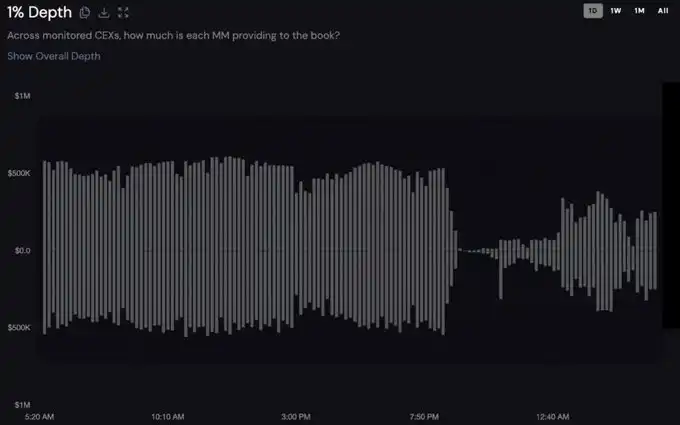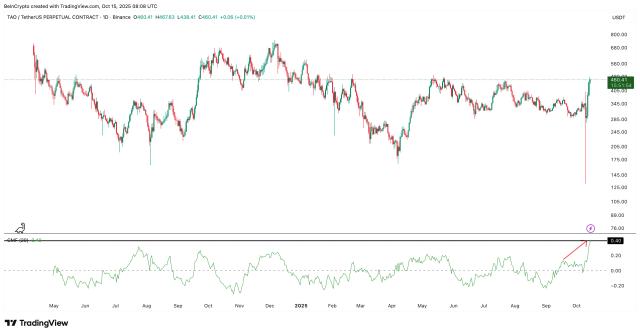Author: Tuao Senior Brother
Original title: The relationship between market makers and the collapse of altcoins during the 1011 disaster night
I saw a lot of KOL tweets today asking why so many altcoins were able to plunge to near zero on the night of the crash. I had similar doubts before, until I figured out how MM actually works on CEX.
This post by @yq_acc specifically talks about the behavior and logic of market makers on the night of the crash. It is definitely worth reading for those who have the patience to understand the operating mechanism.
Today, I'd like to briefly explain some common misunderstandings and questions about MM based on the events of October 11th. Market makers, please feel free to criticize me if I'm wrong. This article is long and dry, with 4,000 words typed by hand. It takes about 5 minutes to read. It wasn't easy to write, so thank you for liking, sharing, and sharing.
Who usually provides liquidity in CEX?
Centralized exchanges (CEXs) actually just provide a platform (casino). In addition to project parties (various gambling tables), traders, and users (gamblers), the active characters on it all year round also include various market makers (MM) who provide liquidity.
Of course, it's not just MMs that actually provide liquidity. Project owners sometimes also provide initial liquidity on CEXs, especially when listing new coins. The cumulative limit buy and sell orders placed by retail investors also contribute to market depth, but compared to professional market makers, retail liquidity is more fragile.
Why this role?
Market makers exist to allow every table to place orders at any time, eliminating the problem of gamblers being left without a counterparty when they want to place their bets. In layman's terms, they act like a lubricant; without them, the market would be very dry. Without market makers, buyers and sellers would need to be matched directly, leading to significant spreads in transaction prices and allowing even small trades to cause significant volatility.
If you go to CEX and try to place orders on both large coins and particularly unpopular small coins, you can feel that large funds can flow in and out of large coins at will with almost no fluctuations, while small coins may cause a 20% loss even if they cost tens of thousands of dollars.
Why doesn’t CEX do MM itself?
The simplest reason is that it requires huge amounts of capital, and the second is because of compliance.
As more and more tokens are created, each token requires liquidity, which adds up to a very large sum. From the perspective of CEX, the most cost-effective thing is to set up the casino stage and let everyone start performing immediately, rather than doing everything themselves.
Therefore, in regions with strict regulations (such as the United States), exchanges such as Coinbase and Kraken must strictly distinguish between matching and market making businesses. Coinbase even established an independent market-making subsidiary (Coinbase Prime/MM).
If a CEX acts as a MM, it is easy to become both a referee and a player: it not only has access to user data (order book, stop-loss points, position direction), but can also trade in its own account, creating a conflict of interest.
This is also one of the reasons why some competitors previously revealed that CEX itself was gambling with users, which caused controversy.
How does MM make money?
Market makers are primarily categorized as passive market makers (MMs) and active market makers, each with distinct profit strategies. Well-known passive market makers include Wintermute, GSR, Amber, and Jump. Active market makers are generally more low-key, but their number is significant, and they are responsible for many of the most popular cryptocurrencies.
Passive MMs primarily earn money through incentives provided by project owners (to maintain a 24-hour market cap). A common structure is a fixed fee plus a variable incentive, such as a $50,000 monthly fee plus a 0.05% bonus based on trading volume. Then there's the issue of over-exchange arbitrage. These traders are often active on multiple CEXs and DEXs simultaneously, capitalizing on price discrepancies.
Active investors are different. They are often deeply tied to project owners, helping them control the vast majority of liquid chips. They then profit through more flexible market practices, such as leveraging margin trading to drive prices higher and then dump stocks, or through short squeezes. Many retail investors' nightmares, including the recent $TRB $MYX, were the work of active investors.
How many MM will be signed for each project?
Many projects may sign contracts with around three MMs in the initial stage, and then after a period of investigation, comparison, and elimination, one or two remain as the main MMs to maintain long-term liquidity support.
Back to the point, why did many Altcoin plummet to incredible levels on October 11th? Is this related to the behavior of market makers?
My answer is: Yes, and it’s huge.
First, as far as I know, there are approximately 50-70 active Market Makers on Binance. During periods of market stability, they provide liquidity for most tokens. However, with the rapid expansion of Altcoin and the resulting decline in liquidity, the liquidity of many older and smaller altcoins is now concentrated near the market price (buy 10, sell 10?), like the shell of an egg.
In non-extreme situations, MM can steadily earn a little difference by constantly buying and selling. At this time, their interests are aligned with those of the project parties, and everything works well.
When the 1011 USDE depegging triggered a sharp drop in wBETH and BnSOL, which then formed a cyclical plunge, a big problem arose in the market: there was a huge conflict between the interests of MM and the need to maintain the depth of the project. To put it more simply, whoever continued to maintain the depth of the buy order would be smashed to pieces and would not even recognize his mother.
If this were you, what would you do?
Let’s look at the timeline:
4:40am real-time tracking data shows the beginning of a catastrophic liquidity withdrawal. Market depth on major cryptocurrencies plummets from $1.2M.
5:00am: A critical turning point, where conditions deteriorate dramatically, with bid-ask spreads widening and order book depth decreasing. This is when a large number of MMs shift from defensive positions to full exits.
5:20am: The chaos peaked. At that time, almost no brokers were still providing services in the market, especially for small coins that had only one or two brokers. After the eggshell was shattered, there was a vacuum of orders below, which led to a 98% plunge (retail investors had long been unable to place orders at such low prices).
5:35am Market makers begin to cautiously return, gradually reaching 80%-90% of pre-disaster levels, but the disaster is already underway.
This chart shows how quickly liquidity disappears:
Therefore, we can actually infer that the real situation at that time was: almost all the MMs who were still awake had begun to sense the coming of the storm after 4:40, and wisely withdrew all their orders and left the battlefield in the following 20 minutes.
More MMs formed a stampede and fled in the next 20 minutes. In the panic, few were willing to abide by the MM agreement signed with the project party - at that time, the money lost by not leaving was far greater than the sweet treats given by the project party.
At that moment, all rational traders were in self-protection mode - not seeking to make a profit, but just to avoid death.
In fact, those MMs who did not wake up in time to discover the problem suffered heavy losses in this wave. Some of them found that they had lost hundreds of millions of dollars after waking up. In the future, 24*7 cross-time zone configuration is likely to become the standard configuration of MM teams.
Why was there no one doing arbitrage when the price gap between Binance and other CEXs was so large?
Don't forget that liquidity on major CEXs is provided by the same group of market makers. Wintermute, GSR, Amber, Auros, and Cumberland all make markets on platforms like Binance, OKX, Bybit, and Coinbase. When risks on one platform become acute (e.g., a surge in Binance futures liquidations), market makers collectively withdraw orders from all exchanges to avoid being implicated in liquidations. Therefore, during those minutes of market turmoil, when price spreads between CEXs are widest, the entire market experiences a liquidity shock. Binance is a prime target for recursive liquidations. Without investors staking their positions to stabilize the price, isn't the price the lowest?
So the conclusion of my long article is:
The current market maker system actually has limitations. When the market is normal, everything runs like a precision machine, but when a black swan appears in the market, it will only compete with retail investors in a panic stampede to see who can escape first.
Simply accusing Binance of maliciously harvesting funds by disconnecting the network simply shows a lack of understanding of the MM system. Binance is a larger target, but Binance is not the same as MM; these are two different things. Of course, the black swan event was triggered by the structural risk of USDe revolving loans, and Binance has a responsibility to prevent it.
However, this crash did expose many problems, including the market maker (MM) system that has been operating for many years and seems to be extremely stable. If CEXs want to go further in the future, it will be important to solve this loose cooperation model where the monkeys scatter when the tree falls.
Twitter: https://twitter.com/BitpushNewsCN
BitPush TG discussion group: https://t.me/BitPushCommunity
Bitpush TG subscription: https://t.me/bitpush









